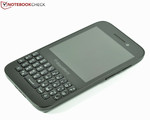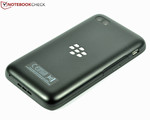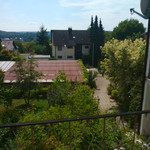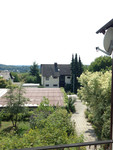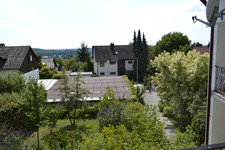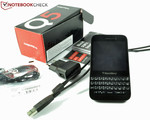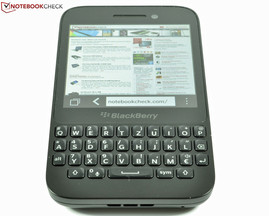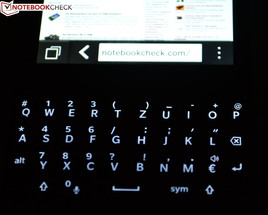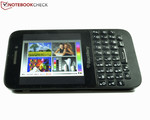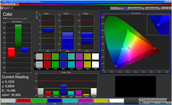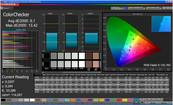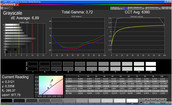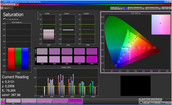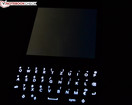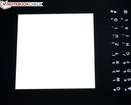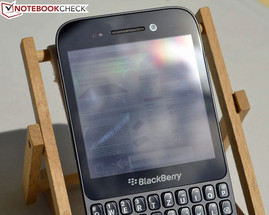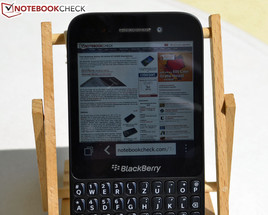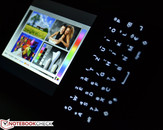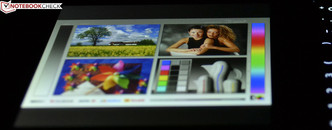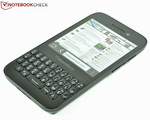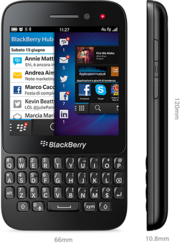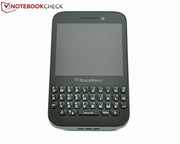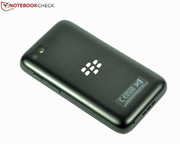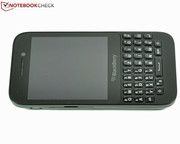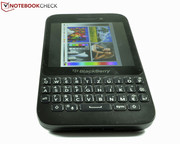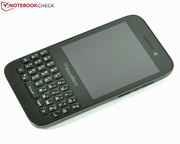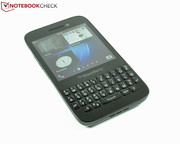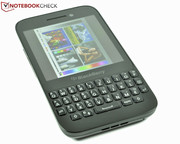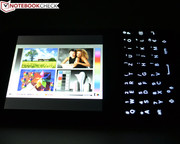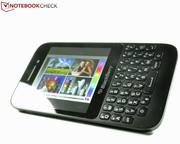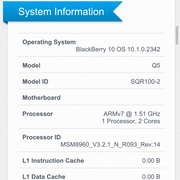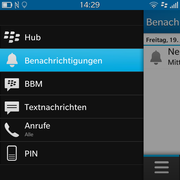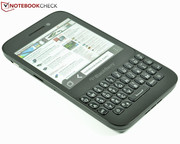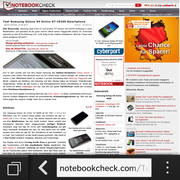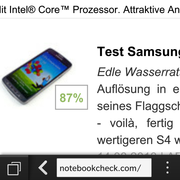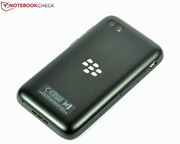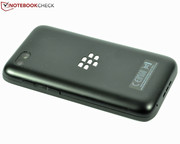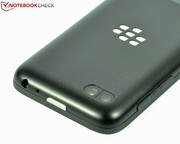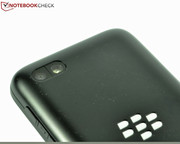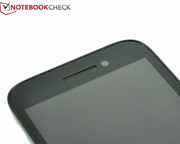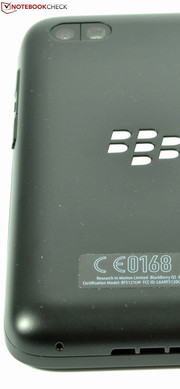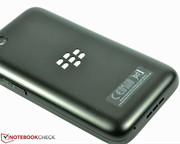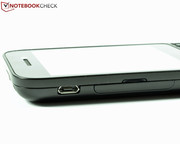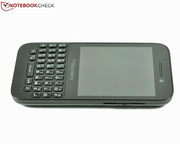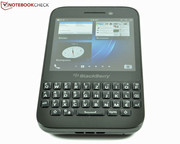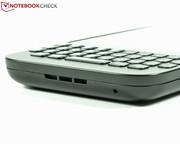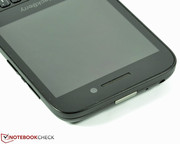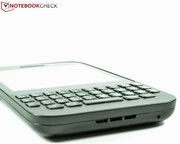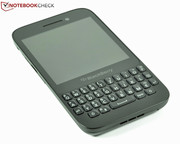Review BlackBerry Q5 Smartphone
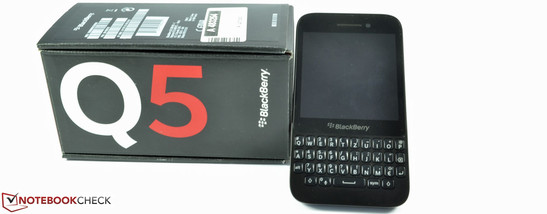
For the original German review, see here.
Following the BlackBerry Z10 and BlackBerry Q10 top-models that we tested, BlackBerry now conquers the upper mid-range with a smartphone. The BlackBerry Q5 however looks like a stripped-down Q10. Its configuration is largely like that of the BlackBerry Q10. It is powered by a Qualcomm Snapdragon S4 MSM 8960 SoC (system-on-a-chip) with a clock rate of 1.2 GHz and an integrated Qualcomm Adreno 225 graphics card. Apart from that, it also sports 2 GB of RAM and 8 GB (net: 5.66 GB) of internal storage. The latter can be expanded by up to 32 GB via a micro-SD card on the 3.1-incher, which also features a bright IPS screen and a resolution of 720x720 pixels. Again, the latest BlackBerry OS 10 version is used as the operating system.
Compared with the Q10, the catalog price has been reduced by a whole 250 Euros (~$334). That is also noticed in our matte-black review sample. But more about that later. The smartphone range for below 400 Euros (~$535) is already cramped but there are barely any comparably equipped contenders. Our BlackBerry Q5 review sample will have to face the very similar BlackBerry Q10 sister model as well as Google's Nexus 4, Samsung's Galaxy S4 Mini, HTC's One Mini, Sony's Xperia SP and Nokia's Lumia 720.
Our test report will reveal whether the phone can assert itself in a shorter update form due to the technical similarities with the tested BlackBerry Q10.
Case
Unlike the BlackBerry Q10 model, the casing of BlackBerry's Q5 is made of polycarbonate. The design based on matte-black plastic is timeless. It is also available in red, white, and pink. Nevertheless, the smartphone makes a slightly cheap impression particularly on the back. This is due to its slightly inferior feel and the unfashionable looking plastic. The casing's stiffness is satisfactory and does not creak even under higher force. The display's pane is also very solid. The power button is comprised of aluminum but the other keys are also plastic.
The build of BlackBerry's Q5 is decent, which the allover even gaps underline. The size of 66 x 120 mm is almost equal with that of BlackBerry's Q10. Its weight of 120 g is much lower than the 140 g of BlackBerry's Q10. That is due to the plastic construction and omission of metal. The 2180 mAh battery is regrettably not removable and the user cannot replace it. The micro-SIM and micro-SD slots are underneath a dubious-looking flap.
BlackBerry's Q5 looks bulkier than its rivals due to its squarish screen and the wide QWERTY keyboard although its dimensions are smaller than almost all its contenders. Only HTC's One Mini and Samsung's Galaxy S4 Mini are a bit slimmer but also a bit longer. The devices are only marginally thinner than the 10.8 mm of BlackBerry's Q5.
Connectivity
Unlike BlackBerry's Q10, the Q5 does not sport a micro-HDMI port. Thus, only a micro-USB 2.0 port and the obligatory 3.5 mm jack for connecting external audio devices are available.
Since the 2180 mAh battery is non-removable, the micro-SIM slot and micro-SD interface for memory cards with a capacity of up to 32 GB have been placed underneath a flap on the casing's left. This flap is also the only major point of criticism in terms of build. It makes a very unstable impression and should be opened carefully.
Software
The operating system BlackBerry 10 OS and the pre-installed software on the Q5 are exactly the same as on BlackBerry's Q10. Therefore we refer to the corresponding in-depth review. The operating system versions differ marginally but we barely noticed any differences in use (BlackBerry Q5: 10.1.0.2309 vs. BlackBerry Q10: 10.1.0.1483).
Communication & GPS
The equipment and performance is virtually identical with that of BlackBerry's Q10. Thus, we again refer to the corresponding review. The review sample features Bluetooth 4 LE (low energy), telephony and data transfer via quad-band GSM, UMTS and even LTE (long term evaluation). A-GPS and NFC (near-field communication) are also available and create an extensive communication bundle. BlackBerry barely made any cutbacks here. Although BlackBerry's Q5 "only" supports Wi-Fi b/g/n, the signal strength quality of the wireless module equals that of the BlackBerry Q10 model.
Telephony & Speech Quality
The smartphone does not show weaknesses here and features all important functions. More information can be found in the review of the BlackBerry Q10.
Cameras & Multimedia
Like BlackBerry's Q10, the front-facing camera has a resolution of 2 MP. The Canadian manufacturer makes cutbacks in the primary camera and installs a 5 MP lens. Although it also features an f/2.4 aperture as well as autofocus and LED flash like the Q10, the picture quality is not satisfying. The pictures exhibit intense image noise, look milky and lack focus and brilliant colors even in well-lit rooms. All in all, the camera modules cannot compete with the contenders.
Accessories
The manufacturer adds a few quick start guides in the black & red box besides the smartphone and its non-removable 2180 mAh battery. Beyond that, a modular 4.25 watt power supply with a 0.90 m USB data cable and a standard BlackBerry stereo headset are included. More accessories, such as cases or external stereo speakers, are listed on BlackBerry's website.
Warranty
BlackBerry limits the Q5's warranty period to 12 months on the device and accessories. Optional upgrades or longer warranty periods are not offered.
Input Devices & Controls
The 3.1-inch touchscreen of BlackBerry's Q5 has a squarish design and implements inputs quickly and accurately. The display's glass pane allows the fingers to glide over it easily and scrolling as well as swiping are detected precisely without problems. The content is not rotated automatically due to the 1:1 aspect ratio.
Although the buttons are not as ergonomically perfect as those of its sister model, the illuminated, mechanical QWERTY keyboard is a highlight of the review sample, like it was in BlackBerry's Q10. The pressure point and decent key drop ensure very good feedback. The other physical keys are absolutely on a par with the keyboard.
Consequently, the same verdict applies as already for BlackBerry's Q10: An intuitive, fast typing speed sets in after only a short period of familiarization. Along with the word suggestion function known from BlackBerry's Q10 and Z10, BlackBerry's Q5 allows speedy typing plus well-organized multitasking.
Display
Like BlackBerry's Q10, our review sample features a 3.1-inch screen with a resolution of 720x720 pixels. Unlike BlackBerry's Q10, an IPS LCD screen that is not as brilliant but much brighter is in the review sample. Regardless of that, BlackBerry's Q5 scores full points in this exercise. More information can be found in the review of BlackBerry's Q10.
BlackBerry's Q5 also struggles with the drawbacks of a glass panel but counters that with a high average brightness of 840.7 cd/m². The review sample can even outshine the impressive brightness of BlackBerry's Z10 (average: 656 cd/m²) with that. This superiority continues seamlessly in the category comparison: Google's Nexus 4 with approx. 275 cd/m², Nokia's Lumia 720 with almost 580 cd/m², Sony's Xperia SP with 389.3 cd/m², Samsung's Galaxy S4 Mini with 298 cd/m² and HTC's One Mini with 466 cd/m². None of the contenders come close to that.
Like in both the BlackBerry Q10 and BlackBerry Z10, the built-in light sensor in BlackBerry's Q5 cannot be disabled. However, the brightness is always adequately adapted. The very homogeneous illumination of 93% is roughly on a par with the competition. Only Sony's Xperia SP surpasses that slightly with 95%.
| |||||||||||||||||||||||||
Brightness Distribution: 93 %
Center on Battery: 866 cd/m²
Contrast: 952:1 (Black: 0.91 cd/m²)
ΔE ColorChecker Calman: 9.1 | ∀{0.5-29.43 Ø4.81}
ΔE Greyscale Calman: 6.89 | ∀{0.09-98 Ø5.1}
Gamma: 3.72
CCT: 6390 K
The IPS LCD screen in BlackBerry's Q5 achieves a black value of 0.91 cd/m² and a contrast of 952:1, which is favorable in practical use. Subjectively, content is displayed with rich black hues and brilliant colors.
The assessments using CalMAN software and the X-Rite i1Pro 2 colorimeter uncovered deficits of the screen in BlackBerry's Q5 with an average DeltaE of 6.89 and partly deviating colors. However, they are barely visible in routine use. An examination using a full white screen only displayed minor deviations and a black screen did not exhibit any irregularities either. The screen's balance looks homogeneous.
Performance
BlackBerry's Q5 is powered by Qualcomm's Snapdragon S4 MSM8960 SoC with a clock rate of 1.2 GHz and Qualcomm's Adreno 225 graphics card that clocks with 400 MHz. The working memory's capacity of 2 GB is sufficient and enables a smooth application performance. Multitasking with various, demanding apps was always swift and reliable. The internal flash memory of 8 GB (net: approx. 6 GB) can easily be expanded up to 32 GB via a micro-SD card. The online storage Dropbox is also available for storing data in the Cloud.
The system-on-a-chip (SoC) installed in the review sample barely differs from that of the reviewed BlackBerry Q10 model (identical SoC but clocked with 1.5 GHz). The performance scores turn out accordingly good.
We will have to limit ourselves to Geekbench 2, since no other benchmarks are available in the store dubbed BlackBerry World which would allow a comparison with Android smartphones. Our review sample achieved 1498 points and is thus approximately 20% behind the scores of the BlackBerry Q10 with 1806 points and BlackBerry Z10 with 1755 points. The contenders also surpass BlackBerry's Q5. Sony's powerful Xperia SP even has a lead of a whole 41%. Only HTC's One Mini has a slighter lead of 7%. The twice as large working memory in our review sample likely contributes to that.
The browser-based benchmarks enable a cross-platform performance comparison. Like in the BlackBerry Z10 and BlackBerry Q10, the BlackBerry 10 browser seems sluggish in our review sample. A direct comparison with the sister models usually revealed a slower performance. BlackBerry's Q5 only sometimes seemed better in the Sunspider 0.9.1 and Peacekeeper benchmarks. The operating system version is apparently the decisive factor here.
Compared with the contenders, BlackBerry's Q5 lags behind in almost all tests. The Google V8 ver. 7 benchmark impressively demonstrates this with up to 186% better results (Samsung's Galaxy S4 Mini). Only Nokia's Lumia 720 presents an almost allover worse performance. However, the review sample clearly defeats Google's Nexus 4 in the Peacekeeper benchmark with 291 to 236 points.
The tide turns in Browsermark 2.0. With 3014 points, BlackBerry's Q5 outperforms all contenders without exception, for example Sony's Xperia SP with 2091 points and is even slightly ahead of HTC's One Mini with 2979 points.
Nevertheless, like the BlackBerry Q10 and BlackBerry Z10 models, the subjective work speed is very high which also always reliably supports the good Wi-Fi reception performance.
| Google V8 Ver. 7 - Google V8 Ver. 7 Score (sort by value) | |
| BlackBerry Q5 | |
| BlackBerry Q10 | |
| BlackBerry Z10 | |
| Google Nexus 4 | |
| Samsung Galaxy S4 Mini GT-I9195 | |
| HTC One Mini | |
| Sony Xperia SP | |
| Nokia Lumia 720 | |
| Octane V1 - Total Score (sort by value) | |
| BlackBerry Q5 | |
| BlackBerry Q10 | |
| BlackBerry Z10 | |
| Google Nexus 4 | |
| Samsung Galaxy S4 Mini GT-I9195 | |
| HTC One Mini | |
| Sony Xperia SP | |
| Nokia Lumia 720 | |
| Mozilla Kraken 1.0 - Total (sort by value) | |
| BlackBerry Q5 | |
| BlackBerry Q10 | |
| BlackBerry Z10 | |
| Google Nexus 4 | |
| Samsung Galaxy S4 Mini GT-I9195 | |
| HTC One Mini | |
| Sony Xperia SP | |
| Nokia Lumia 720 | |
| Peacekeeper - --- (sort by value) | |
| BlackBerry Q5 | |
| BlackBerry Q10 | |
| BlackBerry Z10 | |
| Google Nexus 4 | |
| Samsung Galaxy S4 Mini GT-I9195 | |
| HTC One Mini | |
| Sony Xperia SP | |
| Nokia Lumia 720 | |
| Browsermark - --- (sort by value) | |
| BlackBerry Q5 | |
| BlackBerry Q10 | |
| BlackBerry Z10 | |
| Google Nexus 4 | |
| Samsung Galaxy S4 Mini GT-I9195 | |
| HTC One Mini | |
| Sony Xperia SP | |
| Nokia Lumia 720 | |
* ... smaller is better
Games
BlackBerry's Q5 is set up well in this sector, just like the identically equipped BlackBerry Q10 and BlackBerry Z10 models. The integrated Qualcomm Adreno 225 graphics card renders games, like the race game Riptide GP or skill game Angry Birds Star Wars used for testing, smoothly. For more information we would refer to the reviews of the sister models via the links above.
Speech Quality
This chapter exactly corresponds to that of the BlackBerry Q10 and thus we refer to its in-depth review.
Emissions
Speakers
The Canadian manufacturer has apparently not made cutbacks here because the speaker's performance and quality exactly match that of the BlackBerry Q10. A very good presentation! More information can be found in the corresponding review.
Temperature
The design of the casing of BlackBerry's Q5 seems well-conceived but the review sample's surfaces heat up a bit more than on the BlackBerry Q10, which is likely due to the plastic casing. The temperatures reach a maximum of 30.6 °C in idle. They remain around 29 °C on average. The review sample heated up to a maximum of 32.5 °C during load while playing a Full HD video. An average of 30 to 31 °C is reached. All in all, a good performance.
(+) The maximum temperature on the upper side is 32.5 °C / 91 F, compared to the average of 35.2 °C / 95 F, ranging from 21.9 to 247 °C for the class Smartphone.
(+) The bottom heats up to a maximum of 31.4 °C / 89 F, compared to the average of 33.9 °C / 93 F
(+) In idle usage, the average temperature for the upper side is 29.4 °C / 85 F, compared to the device average of 32.9 °C / 91 F.
Energy Management
Power Consumption
The latest scion of the BlackBerry family proves to be modest in the category comparison. BlackBerry's Q5 consumes between 0.6 and 1.7 watts when idling. The consumption rates range from 2.2 and 3.6 watts during full load. Considering the high brightness, those are very good rates. The review sample fares well in a direct category comparison with that result (maximum rates: HTC's One Mini: 3.8W; Samsung's Galaxy S4 Mini: 3.9W; Sony's Xperia SP: 5.6W; Nokia's Lumia 720: 3.3W; Google's Nexus 4: 6.5W).
| Off / Standby | |
| Idle | |
| Load |
|
Key:
min: | |
Battery Runtime
The manufacturer specifies a runtime of up to 14 days in 3G standby and 12.5 hours of talk time in the 3G net for the BlackBerry Q5. The battery runtimes that we measured verify a very good endurance for the review sample with its 8 Wh battery. The Q5 first stopped running the idle test with minimum brightness after a marathon-like 34 hours.
Our full load runtime test performed with a 1080p video with maximum brightness, ascertained using the flashlight trick known from the BlackBerry Q10 and BlackBerry Z10, finished after 8 hours and 10 minutes. The practical Wi-Fi test ran for a whole 10 hours and 47 minutes before the 2180 mAh battery had to be recharged. We could only achieve a brightness of 150 cd/m² by using the flashlight trick and setting the brightness to 5% because the brightness sensor cannot be disabled.
BlackBerry's Q5 does an even better job than the BlackBerry Q10 in the comparison with the contenders although almost the same battery (Q10: 2100 mAh) is used. The Q10's stronger SoC and the review sample's brighter screen seem to roughly balance each other out.
None of the contenders last as long as BlackBerry's Q5 with approximately 34 hours of idle. Both Google's Nexus 4 and Sony's Xperia SP slightly lag behind the BlackBerry Q5's 7 hours and 20 minutes despite the equally sized or even bigger battery. HTC's One Mini lasts marginally longer with roughly 9 hours although it only sports an 1800 mAh battery, just like Samsung's Galaxy S4 Mini with 1900 mAh and 12 h 10 min and Nokia's Lumia 720 with 2000 mAh and almost 16 hours. The contenders all last between 2.5 and 3.5 hours while the BlackBerry Q5 lasts a whole 8 h 10 min.
Verdict
The BlackBerry Q5 lines in seamlessly in the current smartphone family and reaps in a good rating of 87%. What does it lack for a "Very Good"?
First, we have to mention the backlit QWERTY keyboard positively. It does not quite match the BlackBerry Q10 but it nevertheless conveys a great typing feel. The other controls are also well-conceived. The strong 2180 mAh battery provides really good runtimes. The BlackBerry OS is very instinctive after a bit of familiarization and always runs smoothly. This adds a big plus, just like the perfectly separated business features via BlackBerry Balance. The biggest pro argument beside the keyboard is ultimately the extremely bright, high-contrast IPS LCD screen that scores with its decent subjective color reproduction. We also liked the extensive connectivity which is rare in this category with LTE, NFC and the standard communication modules. The available performance is also consistently good although the smartphone's cold start seemingly takes an eternity with almost 1.5 minutes.
We did not like the material's cheap impression although the BlackBerry Q5 features decent workmanship. The casing is very susceptible for fingerprints and is not very comfortable to hold. The non-removable battery is just as adverse because it cannot be exchanged. The flap for the micro-SD and SIM card slot is unstable and does not make a trustworthy impression. But it is usually not opened very often anyway. The screen is quite small due to the keyboard and browsing or multimedia use, such as with movies or games, are not much fun in the 1:1 aspect ratio. The main point of complaint relates to the poor camera modules that usually make noisy pictures with falsified colors.
Our verdict: Cutbacks have been made in the BlackBerry Q5 when compared with the BlackBerry Q10. But if this is the way austerity measures look in the mid-range, it gets our purchase recommendation.
The review sample is a business-focused niche product that will not appeal to everyone. However, users who are frequently on the go and do not want to shell out an excessive amount of money will be well-served with the BlackBerry Q5 currently available for a street price of 340 Euros (~$455).




